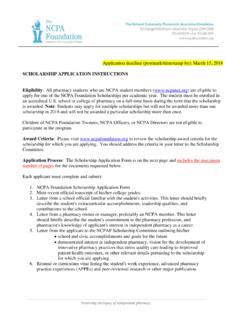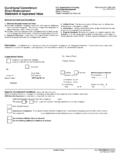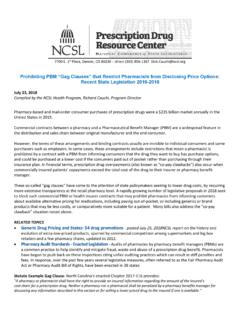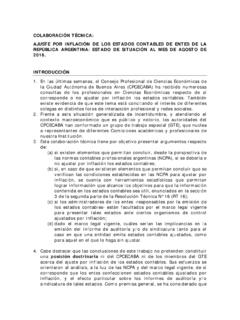Transcription of An FAQ on statin use in patients with diabetes - …
1 36 America s PHARMACIST | Ma r c h 2015 PHARMACY QUALITY MEASURESAn FAQ on statin use in patients with diabetes by Joe BratschWHERE WOULD THIS MEASURE FIT INTO THE OVERALL MEDICARE PART D STAR RATINGS?This measure has been endorsed by the Pharmacy Quality Alliance (PQA). As this issue went to press, this measure has been proposed as a 2017 Display Measure and part of the 2018 Star Rating calculation. If finalized, that means that 2015 data will be analyzed and displayed as information only for the 2017 plan year and that 2016 data would be used in the calculation for the 2018 star WOULD THIS MEASURE ANALYZE?This measure analyzes the percentage of patients between the ages of 40 and 75 who were dispensed a medication for diabetes that receive a statin med-ication. These include oral hypoglycemic medications, insulins, and incretin 37 Editor s Note: This is another in a continuing series of articles covering treatment of various health issues and how they relate to the Medicare Part D Star Ratings RESOURCES Pharmacy Quality Alliance: statin Use in Persons with diabetes : _ statin %20 Use%20in%20 Persons%20with% Standards of Medical Care in diabetes -2014: _ 1 +html 2013 ACC/AHA Guideline on the Treatment of Blood Cholesterol to Reduce Atherosclerotic Cardiovascular Risk in Adults: _ suppl _ 2 +htmlmimetics, alone or in combination.
2 The list of drug classes is as follows: biguanides, sulfonylureas, megli-tinides, alpha-glucosidase inhibitors, thiazolidinediones, incretin mimetic agents, amylin analogs, DPP-IV inhib-itors, insulins, and sodium glucose co-transporter2 inhibitors. statin medications may be prescribed alone or in combination dosage form. The list of statins is as follows: lovastatin, fluvastatin, pravastatin, simvasta-tin, rosuvastatin, atorvastatin, and pitavastatin. The measure would look at patients who were dispensed two or more prescription fills for a hypoglyce-mic agent during the measurement/enrollment year. Enrollment is defined as two or more prescriptions for any medication, with 150 days between the first fill and the last fill, over a 12-month period. WHAT IMPACT WOULD THIS HAVE ON MY PHARMACY?If this measure is included in the star ratings for the Medicare program in the future, the results of appropri-ate statin therapy in persons with diabetes will have an impact on your pharmacy.
3 Medicare Part D plans strive to achieve a five-star level, indi-cating best performance by the plan. Achieving a high star rating is asso-ciated with increased enrollment in plans and awarded bonus payments. If your pharmacy is not meeting the cut points determined annually by Medicare, the plan s ratings could fall. If your pharmacy consistently fails to meet the standards, you may no longer be a part of their preferred network. If your pharmacy excels in ensuring appropriate statin therapy in persons with diabetes , the plan has an incentive to keep you in their IMPACT DOES THIS HAVE ON PATIENT SAFETY?This new measure recommended for endorsement by PQA has patient outcomes as the driver and is based on the 2013 American College of Cardiology/American Heart Associ-ation (ACC/AHA) Guideline on the Treatment of Blood Cholesterol to Reduce Atherosclerotic Cardiovas-cular (ASCV) Risk in Adults.
4 The guideline identifies four groups where statin therapy shows ASCV disease risk reduction. One such group recommended to receive moderate- to high-intensity statin therapy for prima-ry prevention is persons between the ages of 40 and 75 who have diabetes (class I recommendation). The Ameri-can diabetes Association s Standards of Medical Care in diabetes 2014 suggests similar recommendations, indicating statin therapy for diabetes patients with overt cardiovascular dis-ease and for those without cardiovas-cular disease if they are over 40 and have one or more risk factors for CVD: family history of CVD, hypertension, smoking, dyslipidemia, or CAN I DO TO IMPROVE PERFORMANCE IN MY PHARMACY?The first step includes identifying patients living with diabetes and assessing their medication profile for appropriate statin therapy. This can be accomplished by technicians screen-ing patient profiles when they fill a prescription for hypoglycemic agents.
5 If an omission of statin therapy is not-ed, the prescription should be flagged, which will alert the pharmacist to counsel the patient on this opportuni-ty. There are a number of factors that can influence the inappropriateness of statin therapy, including polycystic ovarian syndrome, gestational diabe-tes, or diabetes secondary to another condition. For this reason, the perfor-mance rate goal for this measure is not intended to reach 100 percent. If opportunities are identified during this interaction, the prescriber should be contacted with the appropriate recom-mendations. Joe Bratsch is a 2015 PharmD candidate from the University Of Florida College Of Pharmacy.














